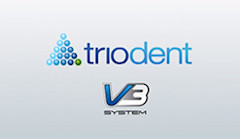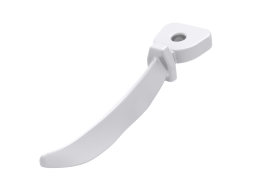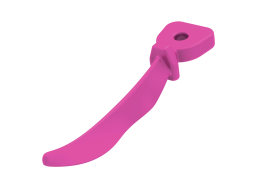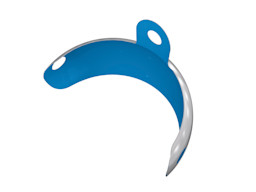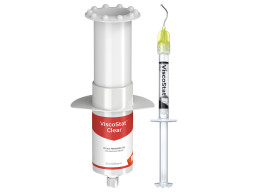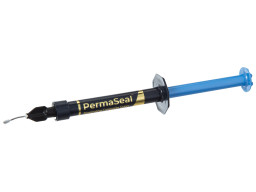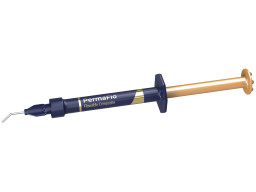Free Standard Shipping on All Orders $285+
Instructions for Use (IFU)
Product Allergens
See any common allergens this product may contain >>Price breaks are offered on most items...
This amount is an estimate based on retail price. The actual amount due (shown at the final stages of your order) may be different from what is displayed here.
Return Policy
Items returned within 30 days of purchase with a return authorization number on the outside and inside of the return box will be credited 100%. Product returned between 31 and 60 days from purchase date is subject to a 20% restocking fee. Ultradent will not accept returns after 60 days. Errors in shipment must be reported within 14 days of invoice date. All return authorization numbers become invalid 90 days after date of issue. A return authorization number must accompany all returns to receive proper credit. Please contact Customer Service at 800.552.5512 for assistance.
Limited Warranty
V3 Ring
The V3 ring's easy-to-use design gives it wide applications for use and—best of all—achieves consistently accurate contacts with predictable results. The super-elastic nickel-titanium ring provides outstanding spring strength and memory. The V-shaped tines ensure there is no competition with the wedge in the embrasure, and they grip both teeth equally, preventing the ring from collapsing into wide cavities. The system is designed to deliver great results even with wide cavities and missing cusps; and it allows for minimal finishing of the restoration.
- New easy-clean feature prevents adhesive from sticking to the ring, even after light curing
- Rings provide greater stability for significantly reduced spring-off
- Best ring for wide cavities
- Outstanding spring strength and memory
- Optimal force for tooth separation
- NiTi for outstanding spring strength and elasticity
- Glass fiber–reinforced plastic tines
- Spring tilt allows for easy stacking of multiple rings
- V-shaped tines accommodate wedge
- Two rings: Universal (green) for large teeth and Narrow (yellow) for small teeth
- Fully autoclavable
Learn more about the SuperCurve Matrix »























Technical Details
Ideal Separation
Part of the Complete System
Clinicals
V3 Ring
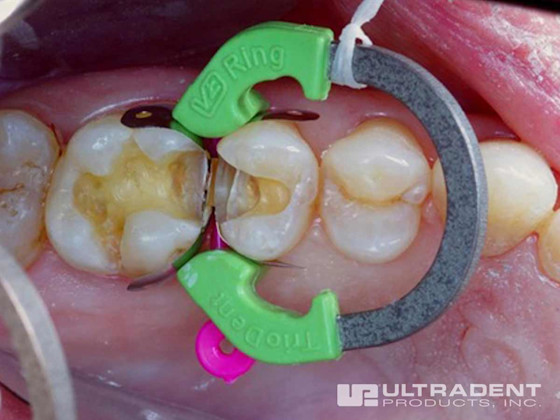
A single V3 Ring can easily hold two back-to-back Tab-Matrices in place. Photo courtesy of Todd Ehrlich, DDS.
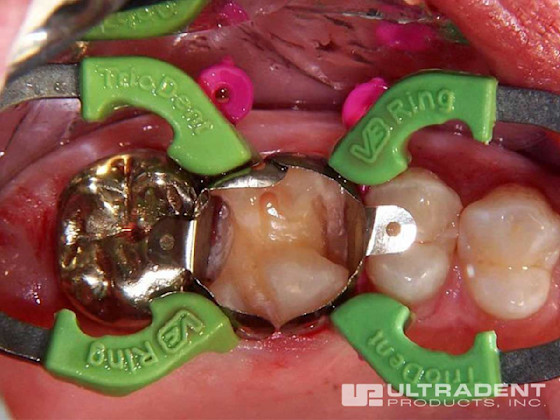
Two V3 Rings used for a first molar MOD. Photo courtesy of David Mastrostefano DDS.
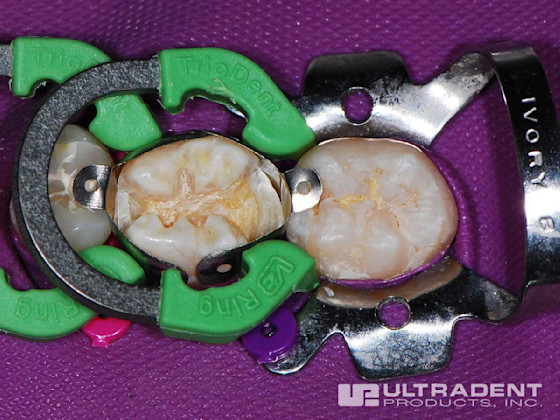
The V3 Ring can be stacked, as shown here for an MOD procedure. Photo courtesy of Gregori Kurtzman, DDS.
Procedures
V3 System
See Instructions for Use for complete instructions, warnings, and precautions.
Step 1

Pre-wedging prevents bleeding during cavity prep. Even better, a Triodent® WedgeGuard will protect the papilla/rubber dam and the adjacent tooth as well. Push the wedge or WedgeGuard in firmly from the lingual or buccal side and proceed with prep.
Step 2
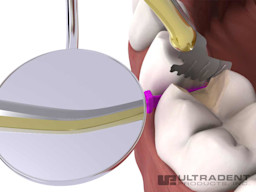
If using a WedgeGuard, detach the guard after prep, leaving the wedge behind. A mirror can be used to hold the wedge in place while the guard is removed.
Step 3
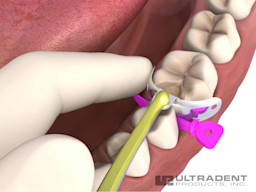
Slide matrix into embrasure.
Grip the tab of a Triodent® V3 Tab-Matrix with Triodent® Pin-Tweezers, ensuring that the gold side of the tweezer tips will be facing away from the tooth. Fold the tab towards you so you can slide the matrix apically into the gingival crevice. If necessary, withdraw the wedge slightly then place the matrix. Now trap the tab of the matrix against the neighboring tooth, and then reinsert the wedge.
Step 4
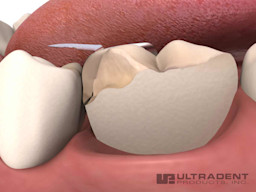
Make small adjustments to ensure the matrix band is at the right height to get maximum benefit from the contour, particularly the rolled marginal ridge, as seen in this cross-section.
Step 5
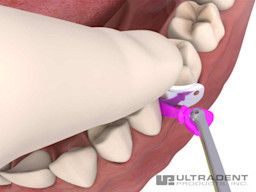
If you are not using a WedgeGuard or prefer not to pre-wedge, you may cut the prep first, then place the matrix and then the wedge.
Step 6
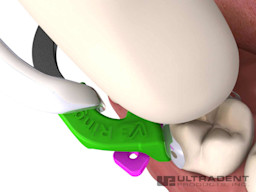
Ask your assistant to pass you a V3 Ring—green for molars, yellow for premolars and primary teeth—already in the forceps with the lock on. Do not rush this next step: Using a finger-rest to steady the forceps, place the ring as low as possible with the tines straddling the wedge. When releasing the forceps, use a finger to press down on the matrix tab to prevent movement.
Step 7
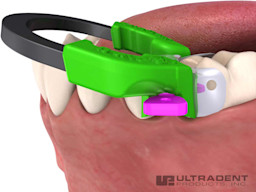
This image shows the V3 Ring in position from the buccal view. Note how the tips of the tines are close to the gingival margin and the V-slot of the V3 Ring is touching the wedge. Make sure that the ring is in direct contact with the wedge and will not move any further in an apical direction.
Step 8
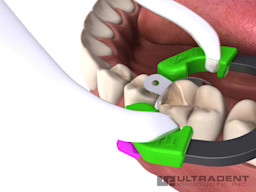
Often it is best to place the V3 Ring distally for better view and access, even with an MO.
Step 9
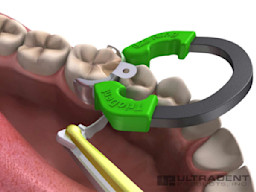
The V3 System allows a second wedge to be placed from the other side, even without removing the ring first. The second wedge can be fitted underneath the first as shown above. This feature enables you to easily adjust the wedging without starting over.
Step 10

Break the bond between the matrix and the composite by pushing a thin, metal-blade instrument through the embrasure below the contact point.
Step 11
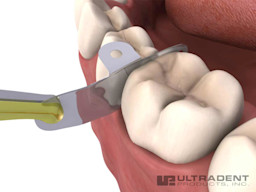
Grip one of the matrix wing holes with Pin-Tweezers and wriggle the matrix gently. If the matrix moves, it is free of the composite and can be removed.
Testimonials
Dr. Patrick Yoshikane –
Dr. Patrick Yoshikane talks about switching from a traditional Tofflemire to the Triodent V3 sectional matrix system and how it changed the way he performs Class II restorations.
Dr. Nick Devani –
Dr. Nick Devani talks about switching from a traditional Tofflemire to the Triodent V3 sectional matrix system and how it changed the way he performs Class II restorations.
“Since incorporating the V3 Ring into the arsenal, I no longer worry about creating good contacts. I can achieve ideal contours at the proximal margins due to the way that the bands adapt to the tooth and the V3 Rings keep the bands adapted and contoured.”
Stephen Sawyer, DDS – Metro Dental, Burnsville, MN
“It would always frustrate me when you would try and put a matrix band around a posterior tooth and it would only seat on one side. The V3 Ring has been a blessing to my practice because not only does it eliminate my matrix band frustrations, but never have I had a problem getting a contact on a posterior tooth, which makes me and my patients happy. The product gets me such tight contacts that sometimes I have trouble getting the matrix band out after the procedure is complete. The system is so quick and easy to use and my favorite part is still the wedges that mimic the gingival papillae. Thanks again.”
Donald J. Annicelle, DDS – Trumbull, CT
“When my V3 Rings are sterilizing and I have to resort to using other methods, no matter how hard I try, I cannot get close to the results I achieve with the V3 Rings. They help me to produce the most anatomical contours and tightest contacts of any system I have tried, and I have tried many.”
Dr. Rob Ramotar – Port St Lucie, FL
“The V3 Ring is the best ring I have ever worked with. It actually perfected Triodent’s previous version of ring. It stays very rigidly in the interproximal area. It doesn’t slip on the tooth or in the ring forceps. If you want the perfect contact with optimal contours you have to use the V3 Ring.”
Saad Bassas, DDS – Sartell, MN
“A no-brainer for any dentist who wants perfect restorations every time.”
Steven B Manson, DDS – Long Island City, NY
“Love it, love it, can’t live without it.”
Sam Hamam, DDS – Clinton, MD
“The V3 Ring has made my life easier from not having to adjust nearly the amount of interproximal flash as the previous rings. It is very durable and does not distort as easy as the previous ring either. Thank you, V3 Ring!!!”
M. Brad Forrest, DMD, PA – Matthews, NC
“I have used every system on the market and hands down, no competition, your system with the plastic wedges, matrix and of course the V3 gives me the predictable contacts that I need and the patients deserve. Thanks for creating such a nice system. Finally, posterior Class II restorations are predictable, fun and rewarding.”
Gordon H West, DDS – Lafayette, CO
“I was a Tofflemire matrix band user for years and the earlier sectional matrix designs, although a fine idea, did not convince me to make a change. The V3 was a slam dunk for me and now I routinely use them to place my Class II restorations. You took a great concept and made it practical for the clinician. Thanks!”
Peter W. Cha, DDS, FAGD – Fredrick, MD
“I have been using the V3 since its introduction and love it. I have recommended it to an Israeli dentist who tried both the green and yellow ones I brought for him to try. He has since then purchased his own and loves it as well. My own dentist has incorporated it into his practice as well. Keep up the great innovations.”
Dr. Stuart Shaffren – New York, NY
“Gone are the fears of finishing a nice-looking composite restoration and then checking the contact and it’s wide open! The V3 Ring has made resin restorations worry free.”
Kevin M. Apolito, DDS – Williamsville, NY
“We’ve been using the new V3 Ring for four months now and are amazed at the great interproximal contacts and reduced finishing time. We have used other ring systems but find the V3 to be the most convenient. We received a free V3 at the Western Regional Dental Convention and all three doctors in our office were vying for it. My son-in-law is in dental school at the University of Pittsburg and I’m sending him a V3 Ring set to use also. Thanks for a great product.”
Stephen Driggs, DDS – Mesa, AZ
“I love the green and yellow V3 Rings! I am getting great contacts and contours on my composite restorations. The matrices, rings and wedges are so easy to use. No more Tofflemire bands! The V3 Rings make composite restorations a cinch!”
Theresa Pham, DDS – San Diego, CA
“I have tried many of the products out there but always ended up frustrated with loose or open contacts until the V3. Now I consistently get good, tight contacts on my Class IIs and IIIs. Thank you, Triodent!”
Dr. Richard A Cea – Colorado Springs, CO
“I have been using the Triodent ring system for about six months. I have used every other ring/matrix system out there. I can say without a doubt that Triodent’s V3 system is the easiest and best. The matrix fits well and the contours adapt almost perfectly to the tooth when the wedge and ring are in place. The pre-wedging step allows you to get a great contact every time. And the interproximal contours are outstanding. Thank you for providing such an outstanding product.”
Mark M Ortinau, DDS, FAGD, FICD – Ellisville, MO
“Been using the V3 Ring for about a year and must say it is the best by far! The whole system, from the pliers to the wedges and matrices, just make it all the better. I even tried the competition’s new-fangled ring and found it too big for most applications. Good going, Triodent!”
Jeffrey Kagihara, DDS – Honolulu, HI
“I called to reorder more rings for my old Triodent system and a Triodent rep told me about the new V3 Rings. I bought one and was instantly hooked. This ring is wonderful! You don’t have to worry about it slipping off the forceps or cutting the gingiva. I have told several of my colleagues about it and I have ordered several more rings myself. My contacts are now better than ever.”
Beatriz T. Dennis, DMD – Greenville, SC
“I have been using your V3 Ring ever since I first got it at the Chicago Midwinter Meeting. I love it with no complaints. It is now my FIRST AND ONLY choice.”
Dr. Gregory Strobel – Chicago, IL
“The V3 Ring and bands have given me the best and most consistent contacts on Class II composites that I have been able to achieve with any other system.”
David R. Hannula, DDS – Tacoma, WA
“I love the ease of use and great contacts the V3 Ring provides to my Class II’s. I used to spend more time contouring the restoration. I would definitely recommend this product to anyone.”
Danny Dinh, DDS – Fredrick, MD
“I started using the V3 Ring about three months ago and I will never return to the old matrix system I was using. I have been so impressed with the nice contacts that I get and I have saved time by having very little finishing afterwards. This makes fillings exciting again! Thank you for your innovation!”
Jeremy White, DDS – Orem, UT
“I love the V3 Ring. It has made restoring teeth so much easier!!!”
Vilma Pelaez Annicelle, DDS – New York, NY
“I wish I had discovered the V3 Ring when I first started doing Class II composites. It is fantastic! Maybe one has to experience multiple times the need for interproximal polishing with a diamond strip to remove overhangs and flash to truly appreciate this great product. My assistants always have polishing strips handy, but with the V3 Ring I rarely need to use them. I also love, really love, the Wave-Wedges. They are gentle to papillae and stay in place well.”
Julie Gillis, DDS – Grand Junction, CO
Frequently Asked Questions
-
Do V3 Rings produce tight contacts?
Yes. Experts agree that Triodent sectional matrix systems – using the V3 Ring - is the surest way to achieve tight contacts since the lateral spring pressure acts like a McKean orthodontic tooth separator.¹ A V3 Ring IS a sectional matrix. The only functional differences between the V3 Ring system and other sectional matrices are:- The V3 Ring is particularly good at holding the matrix in a full anatomical curve.
- The V3 Ring traps the matrix on the shoulders of the tooth and prevents it slipping and moving away from the neighboring contact point.
- The V3 Ring spring is made from nickel-titanium (NiTi) and is very resilient.
- The V3 Ring spans wide cavities.
- The retention is better.
- The tooth separation is better as the lateral force of the spring is greater.
When you think about it, it can't help but produce excellent contacts.
1 Dental Clinics of North America, Vol 45, # 1, Jan 2001, p87. -
Can V3 Rings be used on wide cavities?
Yes. The anatomically-shaped tines grip on both adjacent teeth and this prevents the spring from falling into wide cavity preps (like other sectional matrices). -
Can V3 Rings be used when a cusp is missing?
Yes. Since the tines grip on both teeth on each side of the contact and also low down near the gingival margin, a V3 Ring can often be used when a cusp is missing. Depending on the anatomy, it is sometimes best to build up the bulk of the cusp before placing the V3 Ring. -
Can V3 Rings be used on primary teeth?
Yes. The V3 Ring comes in two sizes – Universal (green) for molars and Narrow (yellow) for premolars and primary teeth. -
What degree of separation is achieved with the V3 Ring?
The ring will create a separation of 60-80 microns. This is greater than the thickness of two Triodent matrices and is sufficient separation to restore two adjacent Class II cavities at the same time. -
Can V3 Rings be sterilized and re-used?
Yes. They are designed for re-use and have been tested successfully through 800 autoclave cycles. The rings should be steam-autoclaved, maximum temperature 135°C. Other methods of sterilization run the risk of damaging or staining the rings. Chemical sterilization will void our warranty. -
How do I remove material that has adhered to the V3 Rings?
Do not soak the V3 Rings in alcohol. Wiping the V3 Rings with a soft cloth soaked in warm water or scrubbing with a soft nylon brush under warm water is effective at removing the majority of materials. If the composite materials are too firmly adhered to the V3 Rings to be wiped away, the material can first be softened by soaking the rings in warm water. Soaking may be followed up by ultrasonic cleaning using a mild detergent such as BioSonic® Enzymatic Ultrasonic Cleaner.* Materials can also be gently wedged and lifted using a blunt plastic instrument such as a composite spatula. Abrasive instruments, like metal dental hand instruments, can damage the surface of the tines and are not recommended. Rings should then be rinsed and steam autoclaved according the IFU.
*Not a registered trademark of Ultradent Products, Inc.
-
How can the extra cost of V3 Rings be justified?
V3 Rings are not much more expensive than other competing systems and they produce better results with less frustration and time spent. They are also made of NiTi and glass-fiber reinforced plastic, which lasts longer. The cost of the consumable V3 Tab-Matrix is similar to other sectional matrix bands. In addition, think how much it costs you every time you have to re-do a proximal restoration because it has a poor contact. If you try to re-do it right away you run late and get stressed out. If you do it later the patient “bad-mouths” you because they think you are incompetent. You lose credibility and waste more time with more costs and no income when you do have to re-do it! Arrrgh! -
Do V3 Rings work equally well on all teeth?
The V3 Ring is a very versatile system and no other matrix system comes close in this respect. -
Do I have to hold the contact point with a burnisher while light curing? Could I use a regular matrix and hold the contact and then why would I need a V3 Ring?
Dr McDonald always does this because it is so easy to do and avoids the bad contact caused by the matrix not being in contact with the neighboring tooth. Quite often it is impossible to see if the matrix is actually touching, so holding is just a precaution. Dr McDonald believes this issue is the single main cause of REALLY bad contacts. The V3 Ring's function is to separate the teeth (orthodontically) and wrap the matrix.
A regular matrix (Tofflemire) when used on a Class II has the effect of moving the tooth in the wrong direction by the thickness of the matrix (because you have to get the matrix through the intact side). This means that you have to overcome TWO thicknesses of matrix to get a tight contact. Tofflemires also tend to produce cylindrical, “tin can”, restorations with a poor contour and a contact just at the marginal ridge. This method has been found to be unpredictable by most who have tried it. -
Which style of clamp should I use to hold the rubber dam in place?
Often there is room for both the clamp and the V3 Ring. Our general advice is to use wingless clamps if space is going to be an issue. For example, on a #30 tooth, try a W3 or W7. Some brands of clamp leave more room than others. Don’t dismiss winged clamps entirely. If possible, place the clamp distal of the tooth being treated. Many dentists also use the Triodent® Wave-Wedge™ routinely to help keep the dam in place. -
Does the V3 Ring work if you are doing three teeth in a row i.e. #12DO, #13MOD, and #14MOL?
Dr McDonald prefers to prep all at once, place the matrices on all teeth then place composite initial layers on all three teeth. Then he finishes layering 12 and 14 and pulls off the matrix on 12 and 14. Next he pushes the wedge in farther between 12-13 and 13-14, burnishes the contact on M and D of 13 and places the final layer on 13. Then he finishes all three at the same time. -
With the V3 Ring is it best to do them all separately start to finish or would you do 12 and 14 together and then 13 by itself?
Yes you can do all four in a row if you want. You just need to make sure that the V3 Ring is separating the contact you are working on. You can move the V3 Ring along as you work, or stack rings. Dr McDonald prefers to use just one V3 Ring as it allows that embrasure to open rather than the retainer rings working against each other. Although he builds one contact at a time, he etches, bonds and places bands and/or matrices all at once. -
The V3 Ring is a small piece of equipment to put in the patient's mouth. What if it springs out or is dropped?
The V3 Ring is very stable on wet or dry teeth because of its strength and anatomically shaped faces. However, for added security tie floss to the ring. -
Can V3 Rings be used on MOD's?
V3 Rings work really well on single Class II restorations and MOD's. You can stack the V3 Rings or have one facing mesially and the other distally. The ring tilts up, away from the marginal ridge of the tooth, allowing more room for another ring to be placed underneath, on the next tooth. In most cases it is advisable to place the rings in opposite directions. -
What's the best way to restore a back-to-back MO or DO?
The easiest method for back-to-back Class II restorations is to complete one and then do the other. Doing both simultaneously can be faster but requires more operator skill. A Narrow (yellow) V3 Ring is recommended as more separation is necessary to overcome two thicknesses of matrix. -
What is the best way to restore an MOD with the V3 Ring?
The recommended method is as follows:- Pre-wedge both M and D and complete cavity preparation.
- Slide M and D matrix into position and etch and bond.
- Place V3 Ring on M and build and cure M contact point.
- Move V3 Ring to D and build and cure D contact point.
- Complete occlusal surface and cure with C-Factor issues in mind.
-
What is the best way to remove the matrix band when it's in a tight contact area and stuck to the composite?
Push a thin, metal-blade instrument like a probe through the embrasure below the contact point to break the bond. Some clinicians also recommend flossing between the restoration and the band. -
Can I place the Wave-Wedge with the V3 Ring in place?
Yes. The V-shaped tines of the V3 Ring allow you to place a wedge without removing the ring. And because the Triodent Wave-Wedge has a hollow underside, you can slide a second wedge from the opposite side to the first. -
When doing an MOD, the matrix band side extrusions are too long and get in the way of the opposing matrix band?
The easy way around this is to place a V3 Ring on the first tooth, trapping the matrix band in place, then bend the protruding ends of the matrix backwards to make room for placement of another band on the opposite side of the restoration. -
Which style of rubber dam clamp should I use on, for example, a #30, that will not interfere with the V3 Ring?
Firstly, it is usually better to use a wingless clamp, say a W3 or W7, but there are other options to consider, like an 8a or a serrated premolar clamp. Yet another thing to try is to use a normal clamp, rotated slightly, on the #31. -
Sometimes when I place the V3 Ring on the SuperCurve matrix, the ring and matrix slip up the tooth. How can I prevent that?
This is most likely to occur on the buccal of lower molars and lingual of upper molars. If it happens, try placing the ring mesially instead of distally. Otherwise, wedge from both sides with Wave-Wedges or use the hard Triodent®V-Wedge to secure the matrix. It’s a good idea to push down on the ring immediately after placement while it is still in the forceps to make sure the ring is fully seated on the undercuts, and keep your finger firmly against the matrix tab until you have released the forceps to ensure there is no slippage.

